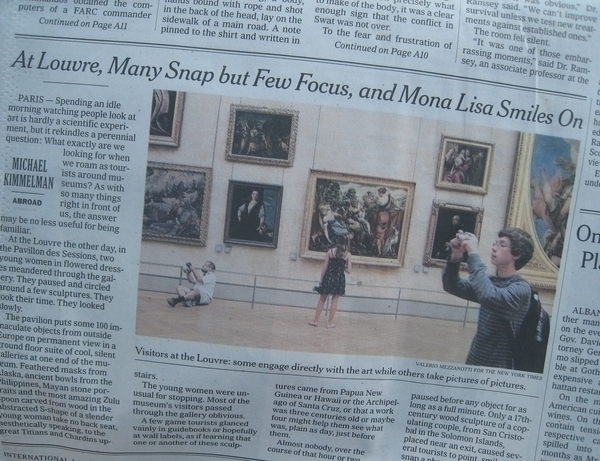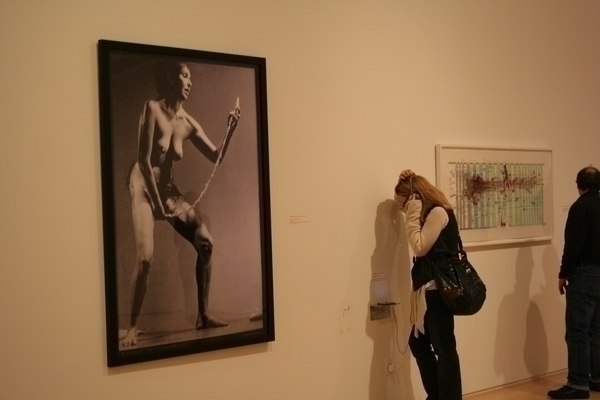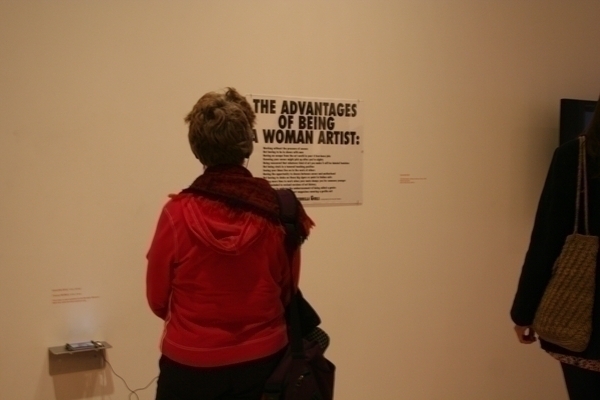Does tech engage or distract?

Did everyone catch Michael Kimmelman’s article in the New York Times yesterday? CultureGrrl adding her own take to museum sprinting was pretty amusing reading, too and the discussion reminded me of a similar one that David Pogue mentioned back in March about his “to film or not to film” a singular event like the Space Shuttle launch. If you’ve ever been to the Louvre, what Kimmelman mentions is not much of a surprise. I was there ten years ago, way before the proliferation of digital and cell phone cameras, but the people watching was much the same. Photos or not, people were bolting for certain objects and ignoring everything in their path along the way. What fascinated me was not the article—by 9AM yesterday, I discovered the NYT had enabled reader comments and I was riveted. If you have not checked those out yet, it’s worth the time to peruse those comments.
As a technologist, I wanted to take the opportunity to look at those comments and discuss the topic of technology in museums, pointing to a recent example of ours. I’ll warn you, I tend to find technology in museums (art museums) rather distracting and I’m not often a fan of what I see implemented. We do a lot of experiments here and I often find myself torn with the results. You may remember that last year, we produced a series of videos and put them on iPod Touches in the gallery. One idea behind this experiment was to produce the videos as lo-fi as possible with the hope that very little production value would encourage visitors to look at the works of art instead of the screens. Rather than just produce audio tracks, we felt like seeing the artist talking would provide a more intimate experience, but by eliminating video-fanciness we were hoping visitors would get started by watching and then shift their attention to the work as they continued to listen.
I spent a lot of time watching people in the galleries and, in a very informal way, found that 80% of the time visitors were totally glued to those screens:

…by contrast, 20% of the time they were starting with the video, then shifting their attention to the work of art the artist was speaking about:

I’ve not blogged about this observation before now because I’ve had conflicted feelings about it. On one hand, I wish I had seen more visitors engaging directly with the works, but on the other…I have to recognize that everyone will engage in different ways and that should be welcome.
I will say as we are getting ready to launch a new project, this idea of how to implement technology, so it promotes art viewing instead of TV watching has weighed heavily in my mind. I’ll talk a bit more about this particular project in a few weeks as we get closer to release, but in the mean time, I’d love to know your thoughts on this issue. For all the museum professionals and museum visitors who read this blog, there must be plenty of opinion out there?

Shelley Bernstein is the former Vice Director of Digital Engagement & Technology at the Brooklyn Museum where she spearheaded digital projects with public participation at their center. In the most recent example—ASK Brooklyn Museum—visitors ask questions using their mobile devices and experts answer in real time. She organized three award-winning projects—Click! A Crowd-Curated Exhibition, Split Second: Indian Paintings, GO: a community-curated open studio project—which enabled the public to participate in the exhibition process.
Shelley was named one of the 40 Under 40 in Crain's New York Business and her work on the Museum's digital strategy has been featured in the New York Times.
In 2016, Shelley joined the staff at the Barnes Foundation as the Deputy Director of Digital Initiatives and Chief Experience Officer.
